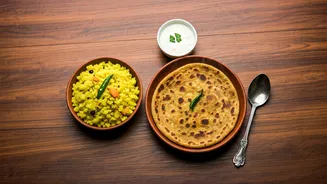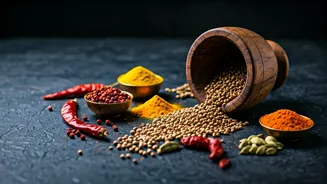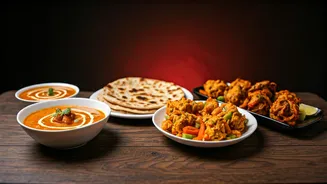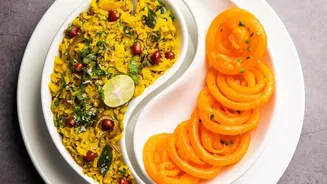Aloo Paratha Power
Beginning with a classic, aloo paratha stands as a beloved winter breakfast. Originating from North India, particularly Punjab and Delhi, this dish consists
of unleavened dough stuffed with a spiced mashed potato mixture. The paratha is then cooked on a griddle with ghee or oil until golden brown. Served with a dollop of butter, yogurt, and a side of pickle, aloo paratha offers a satisfying and warming start to a cold day. The simplicity and heartiness of this dish have made it a staple in many households, perfect for fueling up during winter's chill. Regional variations might include additions of spices and the use of different types of flour, but the core remains the same – a delicious potato-filled flatbread.
Gajar ka Halwa Delight
Gajar ka halwa, or carrot halwa, is a sweet dish that is a winter favorite, especially in North India. This dessert-like breakfast is made by slow-cooking grated carrots with milk, sugar, and ghee. The mixture is simmered until the milk evaporates and the carrots become soft and tender. Cardamom and nuts, such as almonds or cashews, are often added to enhance the flavor. Gajar ka halwa offers a rich, comforting, and sweet experience perfect for colder mornings. It's often enjoyed warm, providing a soothing sensation that complements the winter season. The preparation process, which involves slow cooking, creates a unique texture and concentrated flavor, making it a delicious and cherished breakfast choice.
Sarson ka Saag
Sarson ka saag and makki di roti, a winter pairing originating from Punjab, provides a flavorful and nutritious breakfast. Sarson ka saag is a dish made from mustard greens, cooked with spices and often finished with a dollop of ghee. It’s served alongside makki di roti, which is a flatbread made from cornmeal. This dish is not only delicious but also packs a nutritional punch, rich in vitamins and fiber. The combination of the slightly bitter saag with the buttery roti offers a unique and satisfying taste. Its popularity goes beyond Punjab, becoming a winter staple for many across North India, symbolizing warmth and comfort during the colder months. The rustic simplicity and deep flavors reflect the regional culinary traditions.
Undhiyu Unveiled
Moving to Gujarat, undhiyu offers a unique, mixed vegetable dish. Prepared in an earthen pot and cooked upside down (hence the name), it combines various winter vegetables like eggplant, potatoes, beans, and green garlic. It's cooked with a blend of spices and often includes muthias (small dumplings made from gram flour). The slow cooking process allows the flavors to meld, creating a rich and flavorful breakfast option, especially enjoyed during the winter months. Undhiyu is often served with puri or paratha, creating a satisfying and diverse meal. This dish captures the essence of Gujarat's culinary heritage, showcasing a diverse range of seasonal vegetables and spices.
Upma's Warm Embrace
Upma, a South Indian breakfast, provides a light yet filling start to the day. Made from semolina (rava), upma is cooked with vegetables, mustard seeds, and curry leaves. The preparation involves toasting the rava, then sautéing the vegetables and spices before mixing them. This creates a soft and flavorful dish. Upma's simple preparation and versatility make it a popular choice, particularly during winter mornings when a quick and warming meal is preferred. Variations include adding different vegetables or spices. It's often served with coconut chutney or sambar, enhancing the breakfast experience with fresh and complementary flavors. Upma is a testament to the efficient yet flavorful qualities of South Indian cuisine.
Poha's Pleasantness
Poha, another popular breakfast option, particularly in Maharashtra and Madhya Pradesh, is made from flattened rice. The rice is softened with water and then cooked with onions, potatoes, mustard seeds, and spices. Often garnished with fresh coriander and a squeeze of lemon, poha provides a light and satisfying meal. The preparation process is relatively quick, making it a suitable choice for busy mornings. Poha’s light and airy texture, coupled with its savory flavors, makes it a favored breakfast during winter. Poha's versatility is demonstrated by regional variations, which add different spices and toppings to enhance its taste. It embodies the essence of convenient and delicious breakfasts that provide warmth.
Chole Bhature's Charm
Originating in North India, chole bhature is a hearty and indulgent breakfast. Chole is a chickpea-based curry cooked with a blend of aromatic spices, while bhature is a deep-fried bread made from maida (all-purpose flour). The combination of the spicy chole with the fluffy bhature makes it a satisfying and comforting winter meal. The dish is a popular street food and is often enjoyed with onions, pickles, and green chutney. It's rich and flavorful, providing a substantial start to the day. Though a bit indulgent, chole bhature's popularity endures, offering a taste of celebratory eating perfect for winter gatherings and casual meals.
Idli Sambar Serenity
From South India, idli sambar is a light yet nourishing breakfast. Idli are steamed rice cakes, while sambar is a lentil-based vegetable stew. This combination is a staple in the region and offers a balance of flavors and textures. The soft idli, served with the savory sambar and coconut chutney, provides a comforting and easily digestible breakfast choice, making it ideal during the cooler months. The light nature of this dish doesn’t compromise on flavor, as the sambar is often packed with a variety of vegetables and spices. Idli sambar represents a healthy and delicious way to begin the day, encapsulating the essence of South Indian cuisine.
Pongal's Provisions
Pongal is a traditional dish from South India, particularly popular during harvest festivals but enjoyed throughout winter. It’s a rice and lentil porridge cooked with spices like ginger, cumin, and pepper. Sweet pongal, cooked with jaggery and nuts, offers a sweeter variation. The dish offers warmth and a filling start to the day. The creamy texture and comforting spices make it a perfect winter breakfast. Variations in preparation and ingredients exist. Pongal's significance goes beyond mere nourishment; it is deeply connected to cultural traditions and seasonal celebrations, making it a meaningful breakfast choice during the colder months.
Moong Dal Cheela Magic
Moong dal cheela provides a light yet protein-rich breakfast option. These savory pancakes are made from ground moong dal (split green gram) batter, seasoned with spices. They are cooked on a griddle until golden brown and crispy. This breakfast choice is nutritious and suitable for various dietary preferences. Cheelas are versatile, often served with chutney or yogurt, making them ideal for winter mornings. The protein content makes it a satisfying and energy-boosting meal. Moong dal cheela reflects a blend of health and deliciousness, offering a quick and nourishing start to the day that is easily adaptable to different tastes.
















